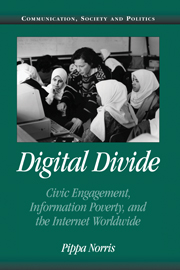Book contents
- Frontmatter
- Contents
- List of Tables
- List of Figures
- Preface
- PART I INTRODUCTORY FRAMEWORK
- PART II THE VIRTUAL POLITICAL SYSTEM
- PART III THE DEMOCRATIC DIVIDE
- 10 Cyberculture
- 11 Civic Engagement
- 12 Conclusions: Promoting e-Democracy
- Appendix A Nations in the Study and Abbreviated Names Used in Figures
- Notes
- Select Bibliography
- Index
12 - Conclusions: Promoting e-Democracy
Published online by Cambridge University Press: 05 June 2012
- Frontmatter
- Contents
- List of Tables
- List of Figures
- Preface
- PART I INTRODUCTORY FRAMEWORK
- PART II THE VIRTUAL POLITICAL SYSTEM
- PART III THE DEMOCRATIC DIVIDE
- 10 Cyberculture
- 11 Civic Engagement
- 12 Conclusions: Promoting e-Democracy
- Appendix A Nations in the Study and Abbreviated Names Used in Figures
- Notes
- Select Bibliography
- Index
Summary
Previous technological breakthroughs have commonly generated exaggerated hopes that machines can transform society and democracy. Luddites fear for the worse, but technophiles hope for the better. In its more Utopian manifestations, this view has been dubbed “technoromanticism,” expressed in earlier eras in response to Samuel Morse's electric telegraph, Alexander Graham Bell's telephone, and Guglielmo Marconi's wireless radio. The more Utopian visions of the Internet suggest a future society in which virtually unlimited qualities of information become available, civic society flourishes, government decision making becomes more open and transparent, and nation-state borders are eroded as people build virtual communities for work, learning, and leisure, spanning traditional boundaries of time and place. Although still in its adolescence, the core transformative capacities of the Internet include its potential for radically shrinking communications and information costs, maximizing speed, broadening reach, and eradicating distance. Compared with radio, television, and newspapers, controlled by editors and broadcasters, the World Wide Web facilitates a virtually unlimited choice of information and communication one-to-one (e.g., via email), one-to-many (e.g., via a personal home page or electronic conference), many-to-one (e.g., via an electronic poll) and, perhaps most important, many-to-many (e.g., an online chat room), with a minimal role for gatekeepers or government censors. Internet messages have the capacity to flow farther, faster, and with fewer intermediaries.
Information
- Type
- Chapter
- Information
- Digital DivideCivic Engagement, Information Poverty, and the Internet Worldwide, pp. 232 - 240Publisher: Cambridge University PressPrint publication year: 2001
